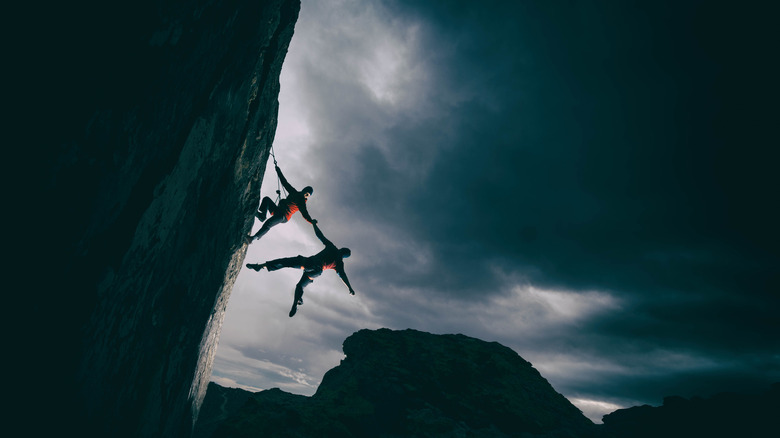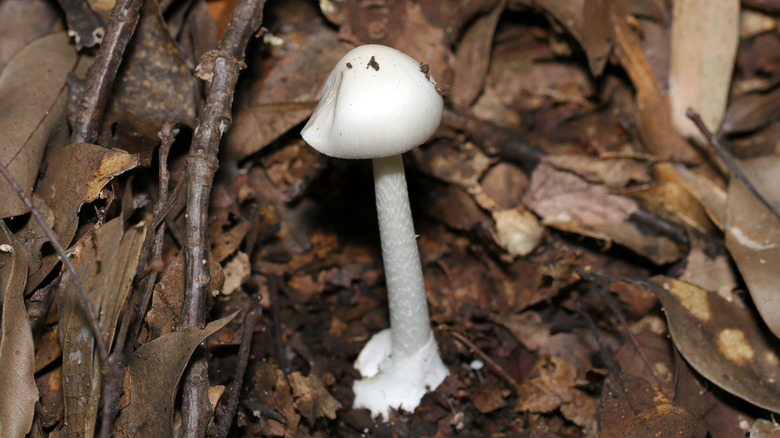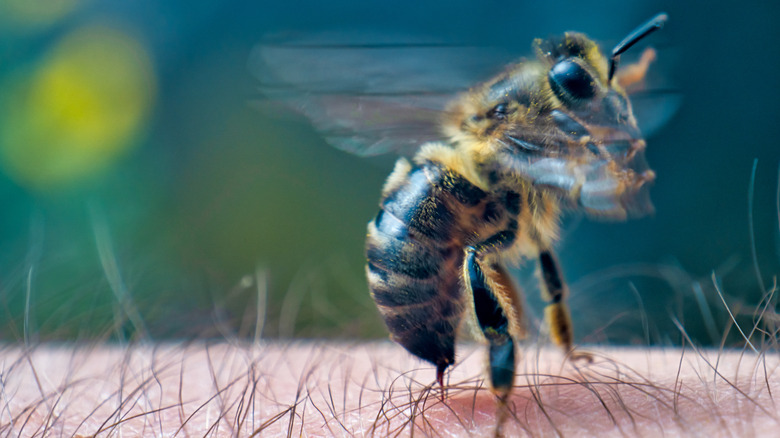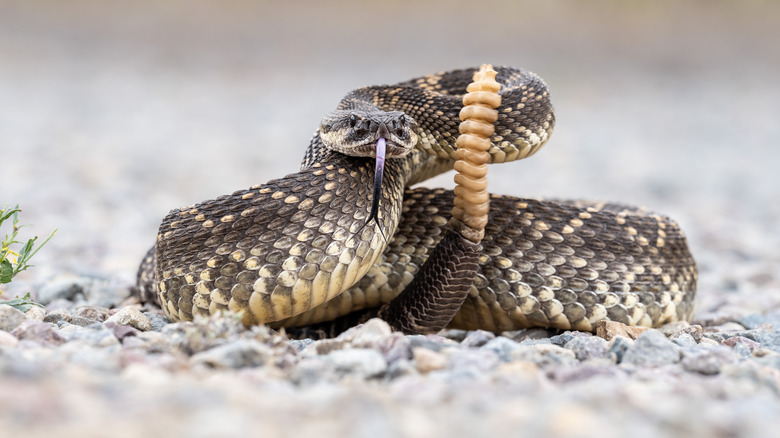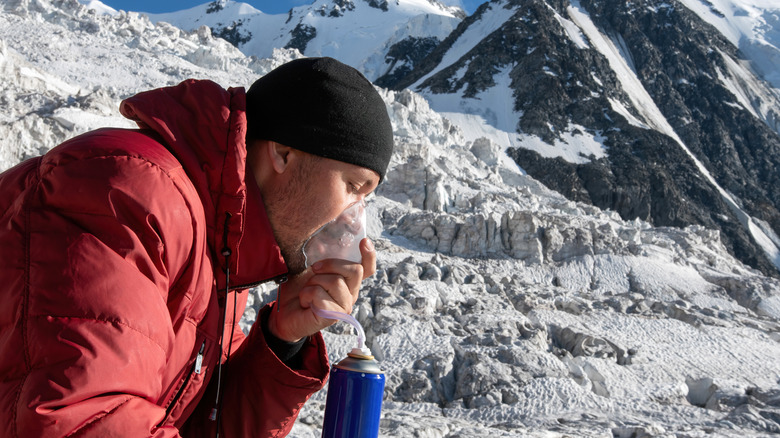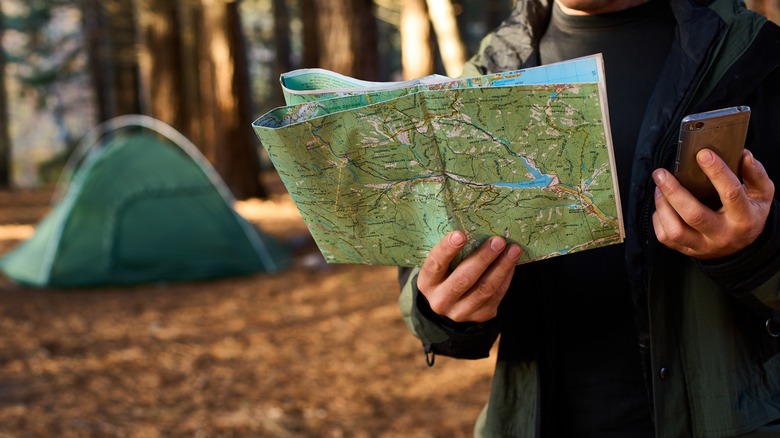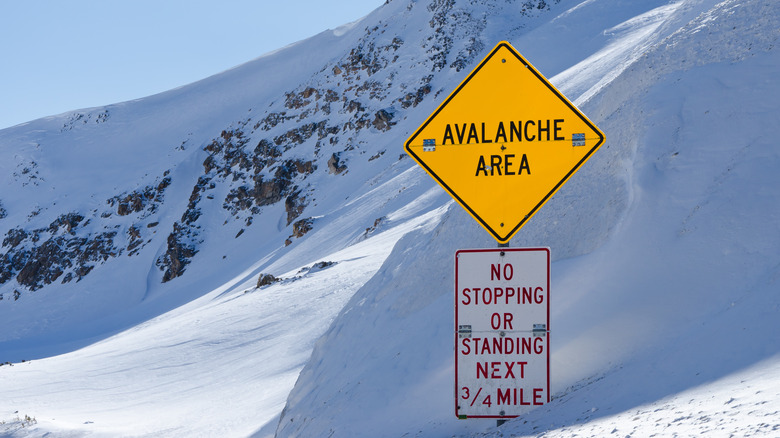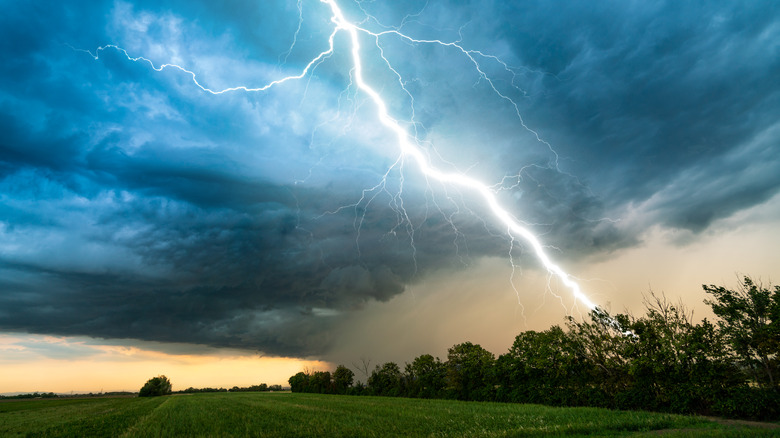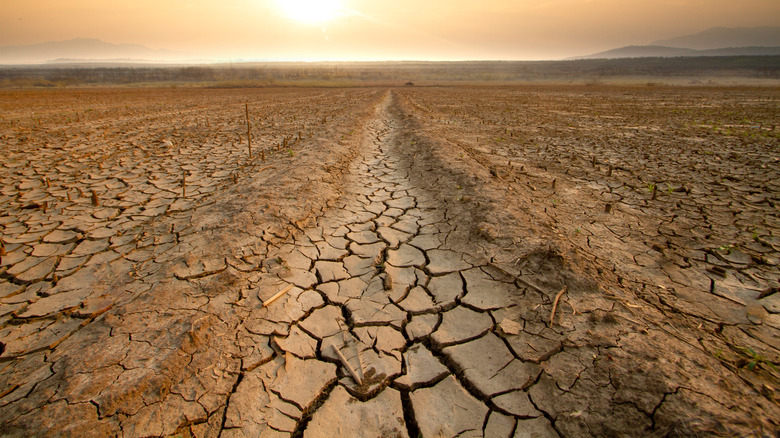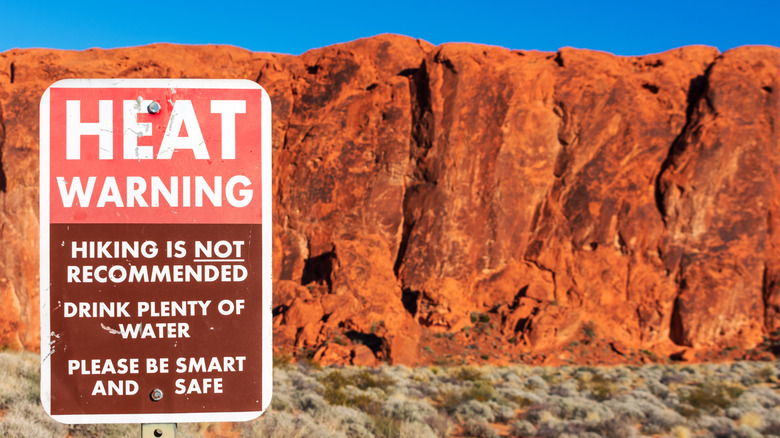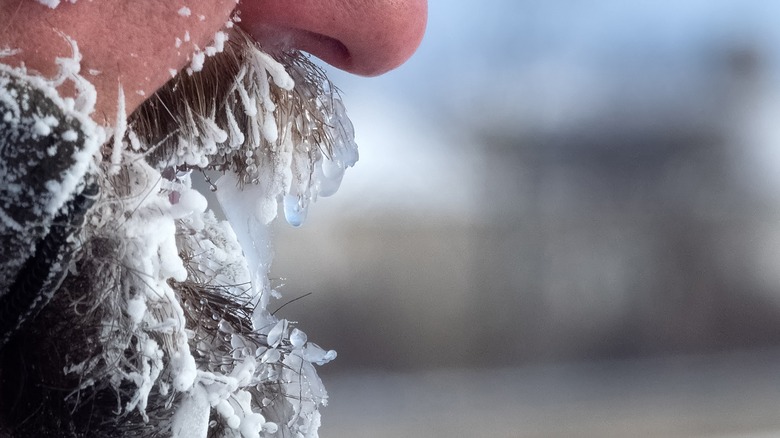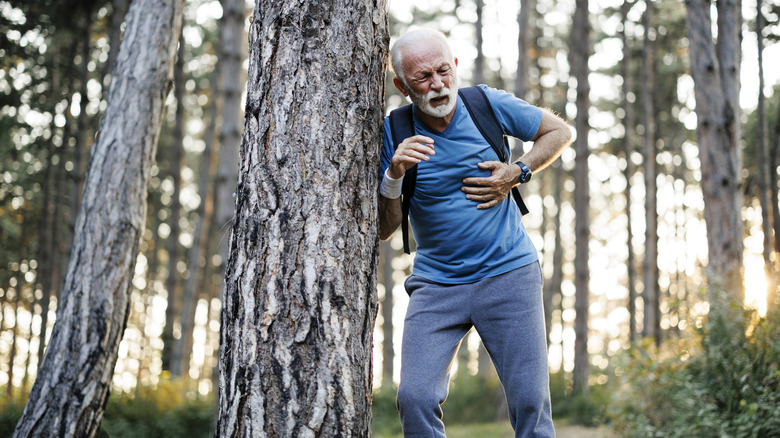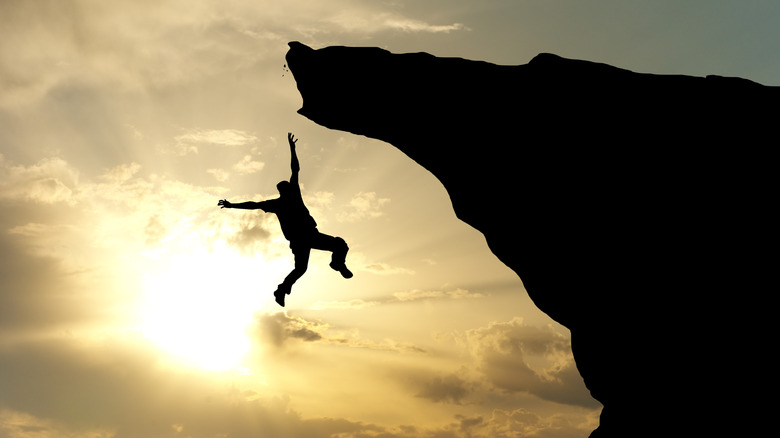The Most Common Ways People Die In The Wilderness
When the hustle and bustle of everyday life catches up, getting outside can be one of the best forms of self-care. A great way to reset from the real world is to connect with nature. Hiking, camping, taking a solo backpacking trip, or even just a walk in the park are all great ways to get outside and enjoy yourself. Not everyone gets the joyous experience though, and you don't have to be in a dangerous location to experience dangerous situations.
Even the most brief trip out in nature should be accompanied by at least some basic safety measures. Even if you're only going on a quick hike or just a scenic picnic, packing supplies in case something unexpected occurs is always the best idea. Nature plays by its own rules, and often, whatever plans were meant to take place have to be exchanged for something new. Even those who never go outside without these expectations can learn that the most prepared person can still meet their fate outdoors, and some ways this can happen are far more common than others.
Poison
Foraging is a pastime many enjoy and a handy skill to have and maintain. A day spent foraging can turn up some delicious and even medicinal foods for little to no cost. At times, though, foraging can be dangerous if you don't know exactly what you're looking at. There have been cases of people making mistakes, and choosing the wrong plant to eat, leading to accidental poisoning. In some cases, this mistake can lead to a person's death.
According to Eat the Planet, in 2016, there were over 5,000 cases of poisonings from plants and mushrooms acquired through foraging and thirteen deaths. This is why it's paramount that you educate yourself on what you're foraging for, and the area you're foraging in. Steer clear of locations that have been exposed to chemicals or heavy pesticides, and carry extra water and a first aid kit just in case.
To gain knowledge about foraging and safe plants to eat, there are a few strategies. You could shadow someone with high-level foraging skills and absorb their information and insight. Another way is to teach yourself by learning about as many plants as possible and educating yourself thoroughly on the region you plan to hunt in. Knowledge, safety, and a healthy amount of caution will go a long way to prevent any unwanted illness or death from a typically enjoyable skill.
Allergic reactions
When someone mentions the outdoors and allergic reactions, there's a chance most people immediately think of poison ivy or poison oak. The truth is, there are a lot of plants and critters explorers can be allergic to. Worse, these allergic reactions certainly don't wait until it's convenient to strike. Unfortunately, people who suffer these reactions don't always know they have allergies to begin with either. Whether someone knows most or all of their allergies or is ignorant of any such thing, an allergic reaction when far from home or any medical facility can be a frightening incident.
Reactions to insect stings from the likes of a bee or a wasp can become so severe that if not treated quickly, can lead to anaphylactic shock and death. An accidental exposure to certain foods can wreak havoc on a person as well. Minor inconveniences like hives may occur, but, in the case of more severe food allergies exposure can be life-threatening.
High pollen days or days with high wind can pose a threat to those with pollen allergies or respiratory problems. For many, too much exposure to pollen can lead to their airways swelling or becoming closed off altogether. Before exploring nature, it's important to make sure you're prepared to handle any reactions that may occur from known allergies.
Wildlife
It may seem obvious that one reason people die in the wilderness is the wildlife, but it isn't as common as many believe. Deaths caused by wildlife are actually quite rare, but they do happen. Dangerous wildlife encounters are often avoidable if proper safety measures are taken.
There are a lot of ways a person can be killed by wildlife, depending on your region of exploration the wildlife that poses the biggest risk can be large or small. In National Parks, between 2007 and 2013, wildlife-related deaths included four people killed by bears, one killed from a snakebite, and one death by mountain goat (via The Washington Post).
A good way to avoid a wildlife-related death is to educate yourself on the area in which you'll be spending time. Learn about the species that frequent the area and what to do if you encounter them. Don't make the mistake of not being prepared for the location you're in as it's the best plan of action. Hopefully, it will be enough to keep your outdoor adventure pleasant and safe.
Altitude sickness
People who are fond of spending time outdoors may frequently make an effort to travel to some of the most breathtaking places. For the lover of camping and hiking, a new terrain is an exhilarating new challenge. However, new terrain comes with more than just a change of scenery and those new to the area, or new to outdoor activities may find themselves blindsided by differences in oxygen.
Altitude sickness can happen to anyone. Whether trying to climb a taller mountain, not realizing how elevated you are, or being a novice explorer, no one is immune to it. This sickness happens when the pressure around you drops and there is less oxygen for you to breathe. When visiting a new location or climbing a higher-than-normal area, stopping periodically to allow yourself to acclimatize to the altitude is necessary. Some acclimate faster than others, but it's important to take the time that you need. If you know you're going to be in an area or participating in an activity where altitude sickness is a threat, it's best to prepare yourself as much as you can before you begin and learn the symptoms which include headaches, little to no appetite, nausea, fatigue, dizzy spells and shortness of breath.
Getting lost
There's a variety of strategies for one to avoid getting lost when in an unfamiliar space. A compass, GPS, the sun, a map, or in some cases, a very good sense of direction are all tools that people can utilize to remain aware of where they are at all times. Even a beginner's knowledge of reading a map is especially important when hiking, camping, or exploring the outdoors in general. Getting lost in the wild can be a terrifying experience that, in a multitude of ways, can lead to a person's death.
Getting lost is a fairly common occurrence. In 2023, Yosemite National Forest Search and Rescue found that 4,661 people were lost in the woods each year (via Survival Dispatch). Not everyone who gets lost is found, though. In Yosemite National Forest alone, 158 people each year are found dead after getting lost in the wilderness. Learning directional skills is one of the best ways a person can save their own life before something bad happens. Losing your way in the wilderness can lead to death by exposure if nothing else, and there's no guarantee that a Search and Rescue team will locate you in time to save you. It's better to educate yourself on a variety of directional tools and go outside prepared for the worst — to prevent the worst.
Avalanche
This one doesn't impact everyone who ventures off into the wild, but the adventurers it does impact should be very aware of the possibility. An avalanche is what happens when a large accumulation of snow rapidly descends a mountain in a formation that looks like a giant snowy wave. Avalanches take with them whatever crosses their path, whether it be trees, living things, or human-made structures.
There are signs of instability that can alert those in the area of a possible avalanche, but they still pose a serious threat to hikers, skiers, and mountain explorers as they leave devastation throughout their path. Not everyone exploring the outdoors needs to worry about a giant wave of snow plummeting towards them, but enough people have to worry about it that it's one of the more common ways someone could die in the wilderness. According to FEMA, in the United States alone, an average of 28 people die each year from getting caught in an avalanche. There are certain things you can do if you're caught in an avalanche to mitigate the possibility of death but if you're notified of conditions that make avalanches more likely like rapid warming, it's best to avoid the area.
Lightning
There are a lot of common misconceptions regarding lighting. For example, the idea that it can never strike the same place twice is a dangerous myth to believe. Lighting can and will strike the same place multiple times, with just as much force. Lightning strikes don't just occur in the wilderness but anywhere outside if the weather is right.
Much like avalanches, an average of 28 people per year die from lightning strikes, per the CDC. Outdoor activities like camping, water sports, and outdoor sports increase the chances of being struck, but there are a few things that one can do to prevent being hit by lightning. Try your hardest to avoid water, if you're out on a lake or river, seek land as quickly as you can. Don't head to elevated areas, and do seek fully-covered shelter. If stormy conditions begin to stir while you're spending time outdoors, it's best to locate a safe spot to wait it out and resume your activities afterward.
Dehydration
Dehydration can be a sneaky affliction that many don't realize is happening until they're experiencing it in full-force. Each year in the United States, at least 518,000 people are admitted to the hospital for symptoms of dehydration (via Everyday Health). These symptoms can be easily overlooked, especially if people are outside doing activities like hiking that cause some exertion.
Symptoms of dehydration to look out for in yourself and others include confusion, nausea, dizziness, and vomiting. Even when it isn't fatal, dehydration can cause problems that can lead to major health concerns like kidney stones, constipation, and muscle damage.
Dehydration can happen in any weather conditions, but winter months may pose the largest amount of danger due to sweat being less obvious in colder conditions and cold, dry air causing our bodies to lose water more rapidly. Drink plenty of water well before you venture outdoors, and continue hydrating during your time outside. If you're out with kids or vulnerable parties, it's important to monitor their water intake as well to prevent hospitalization or worse.
Heat exhaustion
Not every warm day is the perfect day to spend time outdoors doing physical activity. When you're out camping, hiking, backpacking, or doing any other adventuring and far from shelter or medical facilities and the temperature is dangerously high, it's crucial not to over-exert yourself. The consequences of not being cautious on a hot day could be deadly.
According to the CDC, approximately 1,220 people die each year in the United States from extreme heat. Heat exhaustion is what happens when the body loses excessive amounts of salt and water before it can be replenished. This extreme loss typically happens through excessive sweating. Several groups of people are more susceptible to heat exhaustion than others, including those with high blood pressure, the elderly, and those spending time participating in outdoor activities like hiking.
Be aware of the symptoms of heat exhaustion, headache, nausea, dizziness, irritability, thirst, heavy sweating, decreased urine output, weakness, and elevated body temperature. To avoid the possibility of heat exhaustion, it's important to plan by checking the weather and knowing your limits. If the temperature is particularly high, it may be best to hold off on doing too much and stay inside.
Hypothermia
The solution to too much heat isn't too much cold. In extremely cold conditions a person can experience hypothermia, and if it's severe enough they can die. Hypothermia is what happens when a person's core temperature drops below 95 degrees Fahrenheit. Hypothermia can start out with mild symptoms but can rapidly turn deadly and lead to cardiac arrest.
Symptoms of early hypothermia to watch out for are shivering, exhaustion, clumsiness, and sleepiness. Slurred speech, bluish skin color, and a decline in mental function are signs of more moderate hypothermia. Low blood pressure, loss of shivering, loss of reflexes, and a coma are signs of severe hypothermia that could lead to death.
As The Washington Post details, between 2003 and 2007, "cold exposure" was responsible for around 25 deaths in National Parks and in the United States. Between 700 and 1,500 people die from hypothermia each year. Leave the home prepared, and check weather conditions prior to packing your gear so that you can pack accordingly. Know what to look out for, and seek care as soon as any symptoms of hypothermia occur.
Heart attack
A heart attack happens every forty seconds in the United States, whether someone is in the wilderness or at home in their kitchen (via CDC). While getting outside and participating in activities like hiking, backpacking, and fishing, these can all put a large amount of stress on the cardiovascular system, and for those who are less experienced or get little physical activity, the strain and risk can be greater. There are ways to lower the risk of having a heart attack, like knowing your family history and improving your physical condition slowly over time but it can still happen. In many cases, heart attacks can happen to someone multiple times throughout their life, and there are even instances when heart attacks go unnoticed but still damage the body.
If you experience a heart attack while spending time outdoors, it's likely medical services are far away, or that you're in a location with no cell service. This makes it difficult for a person to receive proper care on time. If a person is alone, the situation can become even more dangerous. Heart attacks are a big reason people die in the wilderness because it isn't necessarily something people can foresee in their planning and requires a visit to a medical facility.
Drowning
Some of the most fun experiences outdoors involve water. It's refreshing when the temperatures are high, and it's fun to swim in, surf in, fish in, and boat on, but when people aren't cautious, it can be extremely deadly. Drowning can happen anywhere from the most monitored lake to the most dangerous spots to surf – and to anyone. However, location does make a difference in some cases, and certain groups are more likely to drown than others. As noted by the CDC, children are at the highest risk for drowning, and 40% of drownings in children aged between 5 and 14 happen in natural water.
Like almost any other outdoor activity, there are safety precautions that can and should be taken when planning a day on the water. Learning to swim, using life vests for everyone spending time in and around the water, maintaining a level of awareness by keeping an eye on those in the water, and monitoring the weather are some ways to enjoy the water more safely. Ultimately, spending time in or around bodies of water will always pose a risk of drowning for all involved.
Falling
There isn't a pleasant way to die in the wilderness, but some ways are far more common than others. Falling is the number one accidental cause of death for hikers. One misstep can happen in the blink of an eye. Many are lucky and get back up again with little to no injuries, but depending on where a person lands after their fall, they might not get so lucky.
The National Park Service reports that falls account for around 17 percent of deaths in the parks each year, and overall they account for 50 percent of known hiker's deaths per year. This is why it's important for hikers to remain aware of their surroundings and to know their limits. Hiking a trail while feeling tired from physical activity or weather conditions is a recipe for disaster. Hikers should also take note of where they'll be hiking and obtain proper footwear for that specific terrain.
There are a lot of ways a person could die in the wilderness. Many of them didn't make it on this list, and preparedness for any of these possibilities will lower the risk and make for a much more pleasant experience.
